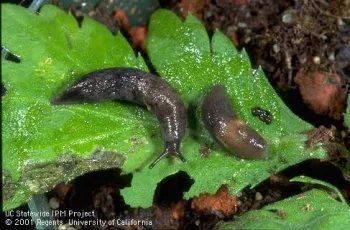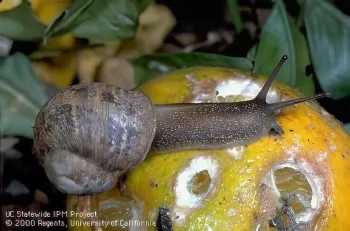Slugs & snails

During the spring and fall, when Marin County gets rain, slugs and snails are a constant presence in my West Marin garden. Much to my chagrin, according to the University of California’s Integrated Pest Management (IPM) program, snails and slugs are among the most destructive pests found in gardens in California. The brown garden snail, Cornu aspersum, which most Marin gardeners recognize, is the most common snail to cause problems in Bay Area gardens.
Slugs and snails are soft-bodied, land-dwelling mollusks that glide along on a muscular foot, secreting mucus as they progress, creating their signature slime trail. They enjoy the moist environment of the garden, particularly after rain.
Only 5% of slugs are above ground - most hibernate in the cool and moist environment of topsoil. They often attach themselves to tree trunks, fences, or walls. Adults are active at night and on cloudy/foggy days but return to their hiding places on sunny days. In areas with mild winters, such as coastal Marin, slugs and snails can be active most of the year.
Both slugs and snails feed on a variety of living plants and decaying plant matter. Their rasping mouthparts cause damage to leaves, flowers, fruits, and other succulent plant parts which appear as irregularly shaped holes with smooth edges. Their favorite menu includes basil, lettuce, strawberries, cabbage, daffodils, hosta, dahlia, delphinium, lobelia, campanula, broccoli, primrose, lilies, and tuberous begonias.

As adult brown garden snails lay an average of 80 pearly white eggs six times a year, it is beneficial to initiate a multi-step management plan. Begin by trying to eliminate as many hiding places as possible, such as under boards, stones, and foliage, in debris, weedy areas around tree trunks, on leafy branches growing close to the ground, and in dense ground covers, like ivy. Ornamental woody plants and grasses serve as hiding places during the day. Twice a week during early spring and fall, wear gloves to hand pick snails and slugs, disposing of them in a bucket of soapy water.
In the evening, set out homemade traps, such as inverted flowerpots, inverted cabbage leaves, or orange or grapefruit rinds filled with a slug bait, like beer or a mixture of boiling water, honey, and yeast. Check the traps daily and dispose of the collected pests every morning until the numbers drop, then check weekly. You can also set and bait deep containers with the rim at ground level. Do not use salt to destroy snails and slugs as it can increase soil salinity.
Erecting barriers is a third step in your management program. Tests show that slugs may receive an electric shock when they crawl over copper if the copper strip or mesh is wide enough to create an effective barrier - wide enough that they are unable to raise their bodies over it. Lime, ashes, or diatomaceous earth slow slugs down but do not kill them. If the edges are buried, window screen material can be used as row covers to protect seedlings.
Choose plants that are less attractive to snails, e.g., plants with highly scented foliage (lavender, rosemary, sage) and other commonly grown plants - ferns, cyclamen, hydrangea, nasturtium, lantana, candytuft, foxglove, nandina, sedum.
Water your garden near sunrise - avoid watering in the evening when slugs and snails come out to feast.
Switching from sprinklers to drip irrigation reduces humidity and moist surfaces which makes the habitat less favorable to these pests. Ensure proper drainage to prevent water accumulation.
If you use materials such as pine bark mulch or wood pellets as mulch to deter slugs and design your garden to include resistant pests, the damage from these pests will be minimal. If chemical control is used as a last resort, choose an iron phosphate bait - e.g., Sluggo which is safe to use around pets, wildlife, and children. Avoid products containing metaldehyde as they are poisonous to cats and dogs.
By Martha Proctor, November 8, 2025
